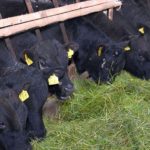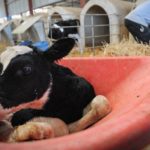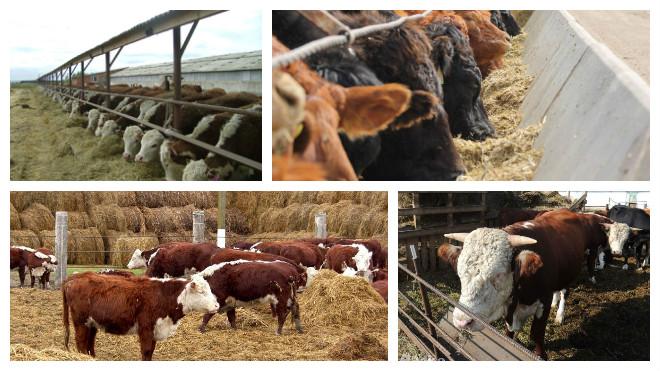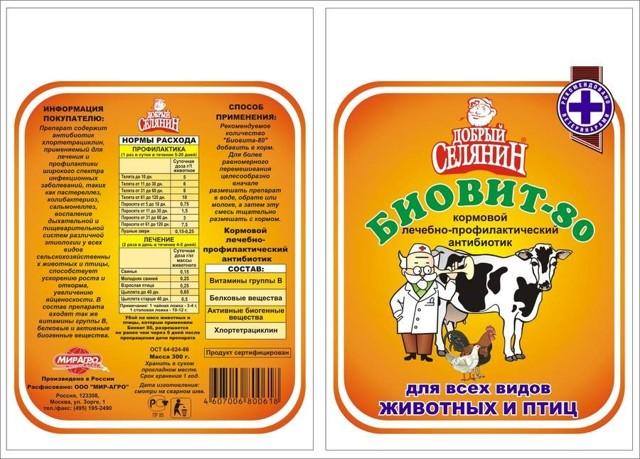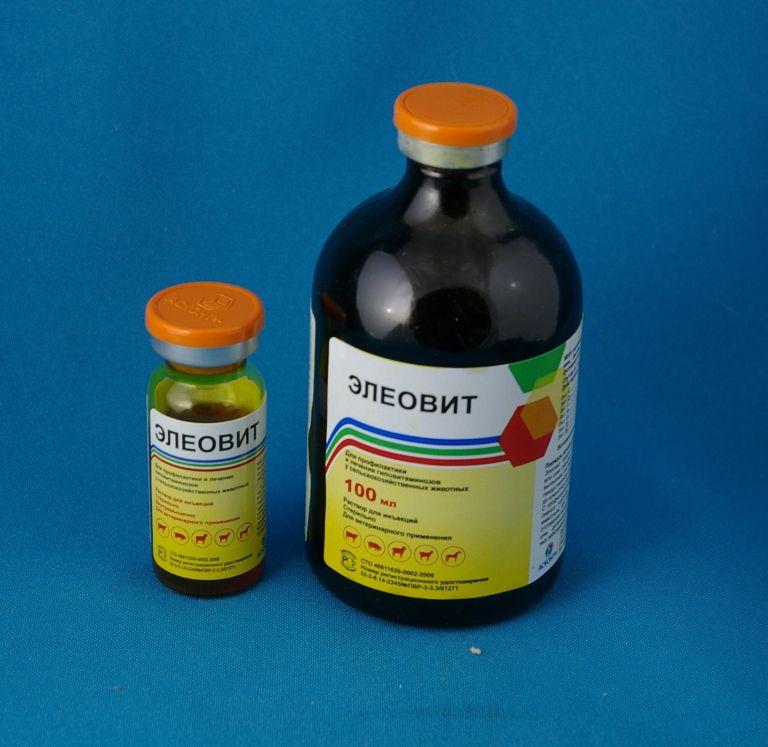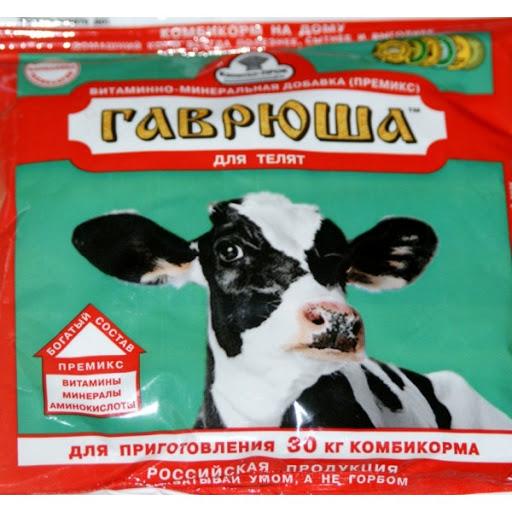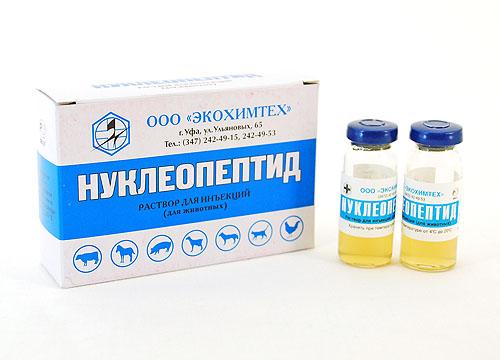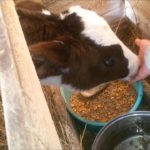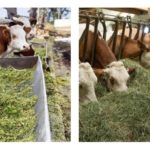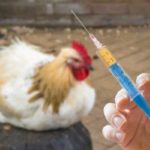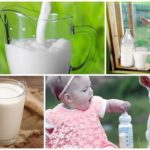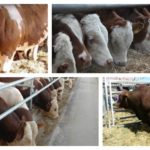Nursing allows the calf to grow and develop. At first, its food is only milk, but from a certain age they begin to feed it with food that adult animals eat. Let's consider the features of feeding calves up to six months and after, what and in what proportions should be given to them, what vitamin supplements can be fed additionally.
What to feed calves at home
At six months the calf is taken away from its mother; until this age it has the opportunity to drink only milk.After six months, his diet consists of what adult animals eat. Therefore, the first year of a cattle’s life can be divided into six months.
Up to six months
The time from 0 to 6 months in the life of a cattle is called the suckling period due to the fact that it mainly drinks its mother's milk. The first food of a newly born baby is colostrum. This is a special substance; in addition to nutrients, it contains hormones and antibodies necessary to activate digestion and immunity. Colostrum should be given to a newborn in the first 2 hours after birth. Feeding with colostrum from the first days should occur 5-6 times a day. After 1-1.5 weeks, colostrum disappears and the calf begins to drink milk. How many times a day a calf needs to drink milk depends on its age.
A one-month-old calf should be fed with boiled potatoes, crushed or flattened grain. You need to feed 1 kg of mixture per animal per day. For a two-month calf, the diet is supplemented with premixes, which should include vitamins A, D, E, mineral elements, chalk and salt, and sulfur. Taken in the right proportions, the components help the animal fully absorb nutrients from food, promote growth, development, and weight gain.
From 3 to 6 months, calves need more protein. At this age, they can be fed root vegetables, mixed feed, crushed grain, bran, vegetables, nutritional supplements, and bean hay. Vegetables and root vegetables must first be grated on a coarse grater, then cut into small pieces so that animals do not swallow large pieces. Feeding frequency: every 8 hours.
If a calf is raised without a cow, then from 3 weeks it can do without milk; instead, the baby is given a substitute, vitamins and premixes. It is transferred to adult food at the same time as the suckling calf. Small animals should not be given low-quality hay, moldy or mixed with poisonous herbs, bread, beets mixed with potatoes. These foods lead to indigestion. A step-by-step feeding scheme can be seen in the table.
| Age | Products |
| 2 weeks after birth | Colostrum, milk, water |
| 1 month | Milk, rolled or crushed grain, boiled vegetables |
| 2 months | Milk, grain, root vegetables, hay, grass, vegetables, premixes |
| 3-6 months | Milk, feed, bean hay, root vegetables, food additives, vegetables, grains |
| 0-6 months (raised without a cow) | CCM, grain, grass, hay, premixes, vitamins and mineral supplements, root vegetables, vegetables |
In 6 months, a calf can eat more than 200 kg of grass or hay (cart), 100-120 kg of root vegetables and the same amount of concentrates.
Features of the diet after six months
After 6 months, the calf needs to be weaned off milk and completely switched to adult food. The nutritional needs of six-month-old cattle vary depending on gender: bull calves grow faster and consume more energy, which means they must receive more food.
The diet of heifers should provide the animals with such a volume of nutrients that by 1.5 years they weigh 360-400 kg. At the same time, it is important to calculate it so that the cows do not lack nutrients, but are not overfed.
From excess, they develop a meat type of build, the animals become fat, puberty occurs early, but reproductive function disorders are possible.
For 1 kg of weight gain during this period, the heifer needs up to 6 feeds. units Steers are fed more concentrates, heifers less. The main product in the diet for cattle at this time is grass or hay, additional products are grain, fodder beets and other root crops, and fresh vegetables. After 10 months of age, calves can be fed straw. It can replace up to a third of the norm of hay.
Growing animals have an increased need for water; they can drink 3 times more liquid than adults. The frequency of drinking for six-month-old cows is at least 3 times a day.
How to get used to mixed feed?
Feed for cattle has a different composition and is intended for animals of different ages. Starter formulas can be fed up to 3 months of age. In addition to nutrients, the mixtures contain probiotics, which prevent disorders of the still imperfect digestion of calves.
You need to get used to mixed feed gradually, giving it in small portions. Animals usually like the taste of combined feeds and eat them willingly. Since the feed is dry, the calves need to be given plenty of water; water should be constantly poured into the drinking bowls.
Popular Vitamin Supplements for Calves
The composition of vitamin supplements produced for cattle includes substances necessary for the growth of young animals. The industry produces ready-made preparations that can be added to the diet of calves from an early age.
"Trivitamin"
This is a complex of 3 essential vitamins (A, D3, E) dissolved in oil. Available in ampoules for injection and powder for oral use.
"Trivitamin" can be combined with feed additives and medications.
"Biovit-80"
The drug is a brown powder, a dried mass of culture liquid of the bacteria Streptomyces aureofaciens.
The drug is given to calves with feed, milk, milk replacer, and water.
"Eleovit"
The drug contains 11 vitamins, vikasol and amino acids.
Eleovit can be combined with supplements and medications.
"Gavryusha"
The premix, which contains vitamins and mineral elements, is intended to be added to feed.
During the period of feeding calves "Gavryusha" there is no need to use other feed additives.
"Nucleopeptide"
The drug is made from cattle spleen extract; it is used to increase weight gain in fattened animals and enhance the resistance of calves to infections.
The use of the drug reduces the time of fattening and rearing calves, helps to save resources spent on rearing. To feed calves from birth to 1-1.5 years, you need to properly prepare the diet and switch the calves to adult food in time. The products must contain proteins, carbohydrates, minerals, vitamins, and fats in the proportions that animals need at this stage of life.


